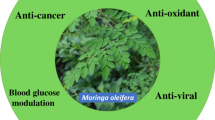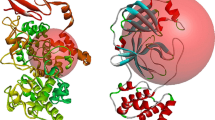Abstract
Mayaro fever, caused by Mayaro virus (MAYV) is a sub-lethal disease with symptoms that are easily confused with those of dengue fever, except for polyarthralgia, which may culminate in physical incapacitation. Recently, outbreaks of MAYV have been documented in metropolitan areas, and to date, there is no therapy or vaccine available. Moreover, there is no information regarding the three-dimensional structure of the viral proteins of MAYV, which is important in the search for antivirals. In this work, we constructed a three-dimensional model of protein C of MAYV by homology modelling, and this was employed in a manner similar to that of receptors in virtual screening studies to evaluate 590 molecules as prospective antiviral agents. In vitro bioassays were utilized to confirm the potential antiviral activity of the flavonoid epicatechin isolated from Salacia crassifolia (Celastraceae). The virtual screening showed that six flavonoids were promising ligands for protein C. The bioassays showed potent antiviral action of epicatechin, which protected the cells from almost all of the effects of viral infection. An effective concentration (EC50) of 0.247 μmol/mL was observed with a selectivity index (SI) of 7. The cytotoxicity assay showed that epicatechin has low toxicity, with a 50% cytotoxic concentration (CC50) greater than 1.723 µmol/mL. Epicatechin was found to be twice as potent as the reference antiviral ribavirin. Furthermore, a replication kinetics assay showed a strong inhibitory effect of epicatechin on MAYV growth, with a reduction of at least four logs in virus production. Our results indicate that epicatechin is a promising candidate for further testing as an antiviral agent against Mayaro virus and other alphaviruses.







Similar content being viewed by others
References
Vieira CJ, Silva DJ, Barreto ES, Siqueira CE, Colombo TE et al (2015) Detection of Mayaro virus infections during a dengue outbreak in Mato Grosso, Brazil. Acta Trop 147:12–16
Vasconcelos PFC, Da Travassos Rosa APA, Pinheiro FP, Shope RE, da Travassos Rosa JFS et al (1998) Arboviruses pathogenic for man in Brazil. In: da Travassos Rosa APA, Vasconcelos PFC, Da Travassos Rosa JFS (eds) An overview of arbovirology in Brazil and neighbouring countries. Instituto Evandro Chagas, Belém, pp 72–99
Coimbra TLM, Santos CLS, Suzuki A, Petrella SMC, Bisordi I et al (2007) Mayaro virus: imported cases of human infection in São Paulo state, Brazil. Rev Inst Med Trop São Paulo 49:221–224
Long KC, Ziegler SA, Thangamani S, Hausser NL, Kochel TJ et al (2011) Experimental transmission of Mayaro virus by Aedes aegypti. Am J Trop Med Hyg 85:750–757
Mourão MP, Bastos Mde S, de Figueiredo RP, Gimaque JB, Galusso Edos S et al (2012) Mayaro fever in the city of Manaus, Brazil, 2007–2008. Vector Borne Zoonotic Dis 12:42–46
Forshey BM, Guevara C, Laguna-Torres VA, Cespedes M, Vargas J et al (2010) Arboviral etiologies of acute febrile illnesses in western South America, 2000–2007. PLoS Negl Trop Dis. https://doi.org/10.1371/journal.pntd.0000787
Pinheiro FP, Freitas RB, Travassos da Rosa JF, Gabbay YB, Mello WA et al (2010) An outbreak of Mayaro virus disease in Belterra, Brazil. I. Clinical and virological findings. Am J Trop Med Hyg 30:674–681
Halsey ES, Siles C, Guevara C, Vilcarromero S, Jhonston EJ et al (2013) Mayaro virus infection, Amazon Basin region, Peru, 2010–2013. Emerg Infect Dis 19:1839–1842
Suhrbier A, Mahalingam S (2009) The immunobiology of viral arthritides. Pharmacol Ther 124:301–308
Figueiredo MLG, Figueiredo LTM (2014) Emerging alphaviruses in the Americas: Chikungunya and Mayaro. Rev Soc Bras Med Trop 47:677–683
Santiago FW, Halsey ES, Siles C, Vilcarromero S, Guevara C et al (2015) Long-term arthralgia after Mayaro virus infection correlates with sustained pro-inflammatory cytokine response. PLoS Negl Trop Dis. https://doi.org/10.1371/journal.pntd.0004104
Lavergne A, de Thoisy B, Lacoste V, Pascalis H, Pouliquen JF et al (2006) Mayaro virus: complete nucleotide sequence and phylogenetic relationships with other alphaviruses. Virus Res 117:283–290
Strauss JH, Strauss EG (1994) The alphaviruses: gene expression, replication, and evolution. Microbiol Rev 58:491–562
Firth AE, Chung BYW, Fleeton MN, Atkins JF (2008) Discovery of frameshifting in alphavirus 6K resolves a 20-year enigma. Virol J. https://doi.org/10.1186/1743-422x-5-108
Snyder JE, Kulcsar KA, Schultz KLW, Riley CP, Neary JT et al (2013) Functional characterization of the alphavirus TF protein. J Virol 87:8511–8523
Gaspar LP, Terezan AF, Pinheiro AS, Foquel D, Rebello MA et al (2001) The metastable state of nucleocapsids of enveloped viruses as probed by high hydrostatic pressure. J Biol Chem 276:7415–7421
Napoleão-Pego P, Gomes LP, Provance DW, De Simone SG (2014) Mayaro virus disease. J Hum Virol Retrovirol. https://doi.org/10.15406/jhvrv.2014.01.00018
Cheng RH, Kuhn RJ, Olson NH, Rossmann MG, Choi HK et al (1995) Nucleocapsid and glycoprotein organization in an enveloped virus. Cell 80:621–630
Choi HK, Tong L, Minor W, Dumas P, Boege U et al (1991) Structure of Sindbis virus core protein reveals a chymotrypsin-like serine proteinase and the organization of the virion. Nature 354:37–43
Choi HK, Lu G, Lee S, Wengler G, Rossmann MG (1997) Structure of Semliki Forest virus core protein. Proteins Struct Funct Genet 27:345–359
Rodrigues VG, Duarte LP, Silva RR, Silva GDF, Mercadante-Simões MO et al (2015) Salacia crassifolia (Celastraceae): chemical constituents and antimicrobial activity. Quim Nova 38:237–242
National Center for Biotechnology Information (NCBI) (2015) http://www.ncbi.nlm.nih.gov. Accessed 21 Jul 2015
Aggarwal M, Tapas S, Preeti Siwach A, Kumar P et al (2012) Crystal structure of aura virus capsid protease and its complex with dioxane: new insights into capsid-glycoprotein molecular contacts. PLoS One. https://doi.org/10.1371/journal.pone.0051288
Guex N, Peitsch MC (1997) SWISS-MODEL and the SwissPdb Viewer: an environment for comparative protein modeling. Electrophoresis 18:2714–2723
Lovell SC, Davis IW, Arendall WB 3rd, de Bakker PI, Word JM et al (2003) Structure validation by Calpha geometry: phi, psi and Cbeta deviation. Proteins 50:437–450
Benkert P, Biasini M, Schwede T (2011) Toward the estimation of the absolute quality of individual protein structure models. Bioinformatics 27:343–350
Maia EHB, Campos VA, Dos Reis Santos B, Costa MS, Lima IG, Greco SJ, Ribeiro RIMA, Munayer FM, Da Silva AM, Taranto AG (2017) Octopus: a platform for the virtual high-throughput screening of a pool of compounds against a set of molecular targets. J Mol Model 23:23–26
Zinc12 (2015) http://zinc.docking.org. Accessed 17 Nov 2015
Chemaxon (2015) MarvinSketch, an advanced chemical editor for drawing chemical structures, queries and reactions. https://www.chemaxon.com/products/marvin/marvinsketch/. Accessed 19 Nov 2015
Morris GM, Huey R, Lindstrom W, Sanner MF, Belew RK et al (2009) Autodock4 and AutoDockTools4: automated docking with selective receptor flexiblity. J Comput Chem 16:2785–2791
Trott O, Olson AJ (2010) AutoDock Vina: improving the speed and accuracy of docking with a new scoring function, efficient optimization, and multithreading. J Comput Chem 31:455–461
Rodrigues VG (2015) Estudo fitoquímico, biológico e de atividades antioxidante e inibitória da acetilcolinesterase de Salacia crassifolia e Maytenus imbricata. Universidade Federal de Minas Gerais, Tese
Dulbecco R (1952) Production of plaques in monolayer tissue cultures by single particles of an animal virus. Proc Natl Acad Sci USA 38:747–752
Mosmann T (1983) Rapid colorimetric assay for cellular growth and survival: application to proliferation and cytotoxicity assays. J Immunol Methods 65:55–63
Pearson WR (2013) An introduction to sequence similarity (“Homology”) searching. Curr Protoc Bioinform. https://doi.org/10.1002/0471250953.bi0301s42
Vyas VK, Ukawala RD, Ghate M, Chintha C (2012) Homology modeling a fast tool for drug discovery: current perspectives. Indian J Pharm Sci 74:1–17
Brozell SR, Mukherjee S, Balius TE, Roe DR, Case DA et al (2012) Evaluation of DOCK 6 as a pose generation and database enrichment tool. J Comput Aided Mol Des 26:749–773
Kim YH, Patkar C, Warrier R, Kuhn R, Cushman M (2005) Design, synthesis, and evaluation of dioxane-based antiviral agents targeted against the Sindbis virus capsid protein. Bioorg Med Chem Lett 15:3207–3211
Takeda-Shitaka M, Takaya D, Chiba C, Tanaka H, Umeyama H (2004) Protein structure prediction in structure based drug design. Curr Med Chem 11:551–558
Lee S, Kuhn RJ, Rossmann MG (1998) Probing the potential glycoprotein binding site of Sindbis virus capsid protein with dioxane and model building. Proteins 33:311–317
Sánchez I, Gómez Garibay F, Taboada J, Ruiz BH (2000) Antiviral effect of flavonoids on the dengue virus. Phytother Res 14:89–92
Zandi K, Teoh BT, Sam SS, Wong PF, Mustafa MR (2011) Antiviral activity of four types of bioflavonoid against dengue virus type-2. Virol J. https://doi.org/10.1186/1743-422x-8-560
Zandi K, Teoh BT, Sam SS, Wong PF, Mustafa MR (2011) In vitro antiviral activity of fisetin, rutin and naringenin against Dengue virus type-2. J Med Plant Res 5:5534–5539
Allard PM, Dau ET, Eydoux C, Guillemot JC, Dumontet V et al (2011) Alkylated flavanones from the bark of Cryptocarya chartacea as dengue virus NS5 polymerase inhibitors. J Nat Prod 11:2446–2453
Frabasile S, Koishi AC, Kuczera D, Silveira GF, Verri WA Jr et al (2017) The citrus flavanone naringenin impairs dengue virus replication in human cells. Sci Rep. https://doi.org/10.1038/srep41864
Lin SC, Chen MC, Li S, Lin CC, Wang TT (2017) Antiviral activity of nobiletin against chikungunya virus in vitro. Antivir Ther. https://doi.org/10.3851/imp3167
Calland N, Albecka A, Belouzard S, Wychowski C, Duverlie G et al (2012) (−)-Epigallocatechin-3-gallate is a new inhibitor of hepatitis C virus entry. Hepatology 55:720–729
Grienke U, Richter M, Walther E, Hoffmann A, Kirchmair J et al (2016) Discovery of prenylated flavonoids with dual activity against influenza virus and Streptococcus pneumoniae. Sci Rep. https://doi.org/10.1038/srep27156
Kuzuhara T, Iwai Y, Takahashi H, Hatakeyama D, Echigo N (2009) Green tea catechins inhibit the endonuclease activity of influenza A virus RNA polymerase. PLoS Curr. https://doi.org/10.1371/currents.rrn1052
Kim M, Kim SY, Lee HW, Shin JS, Kim P et al (2013) Inhibition of influenza virus internalization by (−)-epigallocatechin-3-gallate. Antiviral Res 100:460–472
Goldwasser J, Cohen PY, Lin W, Kitsberg D, Balaquer P et al (2011) Naringenin inhibits the assembly and long-term production of infectious hepatitis C virus particles through a PPAR-mediated mechanism. J Hepatol 55:963–971
Tsukuda S, Watashi K, Hojima T, Isogawa M, Iwamoto M et al (2017) A new class of Hepatitis B and D Virus entry inhibitors, Proanthocyanidin and its analogs, that directly act on the viral large surface proteins. Hepatology 65:1104–1116
Takeshita M, Ishida Y, Akamatsu E, Ohmori Y, Sudoh M et al (2009) Proanthocyanidin from blueberry leaves suppresses expression of subgenomic hepatitis C virus RNA. J Biol Chem 284:21165–21176
Bézivin C, Tomasi S, Lohézic-Le Dévéhat F, Boustie J (2003) Cytotoxic activity of some lichen extracts on murine and human cancer cell lines. Phytomedicine 10:499–503
Acknowledgements
We thank Brazilian Fundação de Amparo à Pesquisa do Estado de Minas Gerais (FAPEMIG) and Conselho Nacional de Desenvolvimento Científico e Tecnológico (CNPq) for the granting of Scientific Initiation grants. We thank the Universidade Federal de São João del-Rei for granting Master’s degree grants and the facilities to carry out this work.
Funding
This work was funded by the Brazilian Fundação de Amparo à Pesquisa do Estado de Minas Gerais (FAPEMIG) CBBAPQ01028-14.
Author information
Authors and Affiliations
Corresponding author
Ethics declarations
Conflict of interest
The authors declare that there is no conflict of interest.
Ethical approval
This article does not contain any studies with animals performed by any of the authors.
Additional information
Handling Editor: Patricia Aguilar.
Electronic supplementary material
Below is the link to the electronic supplementary material.
705_2018_3774_MOESM2_ESM.pdf
Supplementary material 2 Binding energy of the flavonoids and dioxanes docked to the protein C of the MAYV. *Molecules used as parameters for the evaluation of the binding energies obtained in Virtual Screening study with the Protein C of the MAYV (PDF 82 kb)
705_2018_3774_MOESM3_ESM.pdf
Supplementary material 3 NMR spectrum of epicatechin from the extract of ethyl acetate from leaves of Salacia crassifolia. (a) 1H NMR (CD3OD, 400 MHz). (b) 13C NMR (CD3OD, 100 MHz) and the chemical structure of epicatechin (PDF 224 kb)
Rights and permissions
About this article
Cite this article
Ferreira, P.G., Ferraz, A.C., Figueiredo, J.E. et al. Detection of the antiviral activity of epicatechin isolated from Salacia crassifolia (Celastraceae) against Mayaro virus based on protein C homology modelling and virtual screening. Arch Virol 163, 1567–1576 (2018). https://doi.org/10.1007/s00705-018-3774-1
Received:
Accepted:
Published:
Issue Date:
DOI: https://doi.org/10.1007/s00705-018-3774-1




